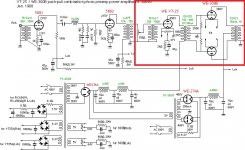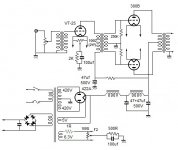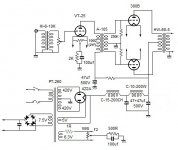This is one of my favorites:
The Feral Eye 2A3 Amplifier Article By Herb Reichert Schematic By New York Triode Mafia
Can also be done with 300B output pairs; driver a 6L6.
The Feral Eye 2A3 Amplifier Article By Herb Reichert Schematic By New York Triode Mafia
Can also be done with 300B output pairs; driver a 6L6.
300B Amp
After studying Sakuma-san website, I decide to go after the attached schematics (only the part in red box) given that it's the most simple one I can find, and that my phono stage's output transformers have 150R output and I also have 150:100Kpp input transformers. The problems here are:
1. the 100R volume control. I couldn't find one.
2. 450V B+ for VT-25, can it be lower?
Please kindly advise me if the direction is ok to go.
BTW, I find that Sakuma-san often uses 150:100K input transformers with 300B or other power tubes. Would it limit the bandwidth?
After studying Sakuma-san website, I decide to go after the attached schematics (only the part in red box) given that it's the most simple one I can find, and that my phono stage's output transformers have 150R output and I also have 150:100Kpp input transformers. The problems here are:
1. the 100R volume control. I couldn't find one.
2. 450V B+ for VT-25, can it be lower?
Please kindly advise me if the direction is ok to go.
BTW, I find that Sakuma-san often uses 150:100K input transformers with 300B or other power tubes. Would it limit the bandwidth?
Attachments
Last edited:
Hi!
When you want to drive 150 Ohm, ideally your source would have much lower impedance. Something like 5 times lower, at least 3 times lower. All depends on the output circuit of your source of course. The 100 Ohm pot would be in parallel to the capacitance and inductance of the step up transformer, so yet a lower impedance.
It is all a matter of what you want to achieve. If you want a high resolution amp, neutral, with good bandwidth, this is not the approach to follow. These high step up ratios are a huge compromise. Sakuma is after tone. I never heard his amps. A friend of mine visited his restaurant once. He described the sound as very good AM radio.
Sorry if this sounds discouraging, but I think this is not the right project to start with. Try a simpler one first and then work your way into transformer coupling. I like Sakumas designs and I adapted many of his techniques, but at the same time try to achieve high resolution and decent bandwidth.
Best regards
Thomas
When you want to drive 150 Ohm, ideally your source would have much lower impedance. Something like 5 times lower, at least 3 times lower. All depends on the output circuit of your source of course. The 100 Ohm pot would be in parallel to the capacitance and inductance of the step up transformer, so yet a lower impedance.
It is all a matter of what you want to achieve. If you want a high resolution amp, neutral, with good bandwidth, this is not the approach to follow. These high step up ratios are a huge compromise. Sakuma is after tone. I never heard his amps. A friend of mine visited his restaurant once. He described the sound as very good AM radio.
Sorry if this sounds discouraging, but I think this is not the right project to start with. Try a simpler one first and then work your way into transformer coupling. I like Sakumas designs and I adapted many of his techniques, but at the same time try to achieve high resolution and decent bandwidth.
Best regards
Thomas
I do appreciate all the responses here and for my project I go after a high resolution, neutral and good bandwidth amp, so it's not necessary to just isolate to Sakuma-san's amps.
Currently, I have another option which is quite close to Audio Note Kegon Balanced amp. It will use 1:3 input transformers --> 10Y --> 1:1 push pull interstage transformers --> 300B. Is it ok to go?
Currently, I have another option which is quite close to Audio Note Kegon Balanced amp. It will use 1:3 input transformers --> 10Y --> 1:1 push pull interstage transformers --> 300B. Is it ok to go?
I can offer a few observations. A good choice of interstage is the Hammond 126C. This is seriously good - not a cheap compromise, though it is a lot cheaper than other options. I've used this a few times with a 46 driver - they are a good sounding combination. Inductance is 106H. I preferred the 46 over the 10Y here, but probably because I find it sounds better with unbypassed cathode and 46 has lower plate resistance.
I'm currently using a 2a3 PP amp with 6.6K O-netics OPTs. Though it doesn't quite have the midrange tone of the 300b SET, it has very good bass and treble, better dynamics and more grip on complex passages. I'm using 4P1L drivers in differential pair. These need at least 15mA or indeed more (?20mA) through them. I run the filaments at 3.8v and I'm not getting microphonics issues. This is the first time I've used these tubes, and I'm optimistic - cheap on ebay and I've ordered more.
I always use an interstage or plate choke, and here I'm using a Hammond 124b as plate choke - just the 90k side with the centre point to B+. Russian FT-3 teflon caps. I'm going to try some Lundahls instead - LL1660, 1671, 1635, 1621.
Another option for a PP amp (300b, 2a3) is a single ended input like 46 or 4P1L into a phase splitting interstage. I have a LL1660/18mA which I want to try with 46 and 4P1L. It would be nice to use this with filament bias, but would need a high voltage filament supply. I've done this with a 10Y at lower current. So there's a potential 10Y to PP300b circuit here. See Alt V in the datasheet - 2.5:2+2. Lundahl do specially balanced versions for phase splitting.
The only thing I'm not clear about here is whether the primary inductance is sufficient in Alt V - with the LL1660/10mA it's stated as 42H. With the LL1660/18mA I'm guessing more like 36H. This is pointing to a 2a3 driver or a 6B4G. You could wire the primary in series to get 4.5:2+2 which would give greater primary inductance with a loss of gain, but the 4P1L has a mu of 11 which is useful.
Thomas or Kevin - could you advise?
Andy
http://www.lundahl.se/pdfs/datash/1660.pdf
I'm currently using a 2a3 PP amp with 6.6K O-netics OPTs. Though it doesn't quite have the midrange tone of the 300b SET, it has very good bass and treble, better dynamics and more grip on complex passages. I'm using 4P1L drivers in differential pair. These need at least 15mA or indeed more (?20mA) through them. I run the filaments at 3.8v and I'm not getting microphonics issues. This is the first time I've used these tubes, and I'm optimistic - cheap on ebay and I've ordered more.
I always use an interstage or plate choke, and here I'm using a Hammond 124b as plate choke - just the 90k side with the centre point to B+. Russian FT-3 teflon caps. I'm going to try some Lundahls instead - LL1660, 1671, 1635, 1621.
Another option for a PP amp (300b, 2a3) is a single ended input like 46 or 4P1L into a phase splitting interstage. I have a LL1660/18mA which I want to try with 46 and 4P1L. It would be nice to use this with filament bias, but would need a high voltage filament supply. I've done this with a 10Y at lower current. So there's a potential 10Y to PP300b circuit here. See Alt V in the datasheet - 2.5:2+2. Lundahl do specially balanced versions for phase splitting.
The only thing I'm not clear about here is whether the primary inductance is sufficient in Alt V - with the LL1660/10mA it's stated as 42H. With the LL1660/18mA I'm guessing more like 36H. This is pointing to a 2a3 driver or a 6B4G. You could wire the primary in series to get 4.5:2+2 which would give greater primary inductance with a loss of gain, but the 4P1L has a mu of 11 which is useful.
Thomas or Kevin - could you advise?
Andy
http://www.lundahl.se/pdfs/datash/1660.pdf
Last edited:
I currently have a pair of Hashimoto A-105 interstage transformers (http://www.tube-amps.net/images/Hashimoto_Specs/A-105_1024.jpg) and a pair of Hashimoto HW-60-5 output transformers (http://www.tube-amps.net/images/Hashimoto_Specs/HW-60-5_1024.jpg). For input transformers, I'm going to use a pair of Hashimoto HL-10K-6 transformers (http://www.tube-amps.net/images/Hashimoto_Specs/HL-10K-6_1024.jpg). Are they ok for my project?
VT25 - 300B amp
The schematics would look like this. Can you please kindly advise me the optimum B+ levels for VT-25 and 300B tubes?
As the input transformers are Hashimoto HI-6-10K (600:10K) transformers is it ok to use 100K volume control?
The schematics would look like this. Can you please kindly advise me the optimum B+ levels for VT-25 and 300B tubes?
As the input transformers are Hashimoto HI-6-10K (600:10K) transformers is it ok to use 100K volume control?
Attachments
Last edited:
The schematics would look like this. Can you please kindly advise me the optimum B+ levels for VT-25 and 300B tubes?
As the input transformers are Hashimoto HI-6-10K (600:10K) transformers is it ok to use 100K volume control?
Andersen, "optimum" levels depend on design (class A; class AB a.s.o.).
You come up with rather ambitious designs, and in IMO these are for the more experienced.
I advice to begin with a known design of which all parameters are given, so the chance of success is there (and you learn in the meantime).
No, 100k volume controls do not mate very well with a low input impedance that you have with a 1:4 step up input transformer.
Last edited:
Hi Andy,
I have to agree to Pieter and I would also again encourage you to start with a simpler project or with a schematic which is proven. This would help you a lot to learn and then as a second attempt build an all DHT amp. There is more to good amp design than just selecting a B+ or arbitrarily choosing a volume pot.
BTW a resistive volume pot would destroy some of the advantages of such a transformercoupled amp IMHO. This just begs for a preamp with TVC.
In my experience, the filament supply of a 10Y is critical. I had poor results with such filament supplies as drawn in that schematic.
You might want to check my blog for some insight into amp design. Check the single ended amplifier concept series of articles which might give some direction and go from there. Here is the first part of these articles:
VinylSavor: Single Ended Amplifier Concept, Part 1
Also read tube datasheets, look at the plate curves and put in your loadline and op point there to understand how it will work.
Best regards
Thomas
I have to agree to Pieter and I would also again encourage you to start with a simpler project or with a schematic which is proven. This would help you a lot to learn and then as a second attempt build an all DHT amp. There is more to good amp design than just selecting a B+ or arbitrarily choosing a volume pot.
BTW a resistive volume pot would destroy some of the advantages of such a transformercoupled amp IMHO. This just begs for a preamp with TVC.
In my experience, the filament supply of a 10Y is critical. I had poor results with such filament supplies as drawn in that schematic.
You might want to check my blog for some insight into amp design. Check the single ended amplifier concept series of articles which might give some direction and go from there. Here is the first part of these articles:
VinylSavor: Single Ended Amplifier Concept, Part 1
Also read tube datasheets, look at the plate curves and put in your loadline and op point there to understand how it will work.
Best regards
Thomas
Hi Andyjevans,
WRT to the Lundahl ITs they are gapped for specific currents so if you purchase one specified for 10mA you should run it that current level, at 18mA it is very likely that the core will just barely saturate. The LL1660 can also be ordered gapped for 18mA and at that level provides a pretty healthy 100H of inductance. (Ok for an rp of up to about 7 - 8K I'd swag, depending on how deep you want the bass to go)
Lundahl Catalog Page
I use Lundahl LL1635/20 in my GM70 and they work really well.. I run them at exactly 20mA driven by D3A. Note that these will saturate at 175% of static DC rating.
WRT to the Lundahl ITs they are gapped for specific currents so if you purchase one specified for 10mA you should run it that current level, at 18mA it is very likely that the core will just barely saturate. The LL1660 can also be ordered gapped for 18mA and at that level provides a pretty healthy 100H of inductance. (Ok for an rp of up to about 7 - 8K I'd swag, depending on how deep you want the bass to go)
Lundahl Catalog Page
I use Lundahl LL1635/20 in my GM70 and they work really well.. I run them at exactly 20mA driven by D3A. Note that these will saturate at 175% of static DC rating.
Hi Kevin,
Andy refers to connection alternative V in the datasheet, which uses two windings in parallel as primary. Wired such the current capability doubles.
Andy,
Lundahl lists in the datasheet a recommended source impedance for this connection and a corresponding frequency response. Frequency response will be wide with lower source impedances, but also high frequency ringing can increase.
Best regards
Thomas
Andy refers to connection alternative V in the datasheet, which uses two windings in parallel as primary. Wired such the current capability doubles.
Andy,
Lundahl lists in the datasheet a recommended source impedance for this connection and a corresponding frequency response. Frequency response will be wide with lower source impedances, but also high frequency ringing can increase.
Best regards
Thomas
Hi Thomas and Kevin,
I'd neglected to notice that in parallel the current capacity is doubled - obvious when you point it out.
But tell me more about ringing with lower impedences? What is this about? How does this vary if the cathode resistor is bypassed or unbypassed?
Andy
I'd neglected to notice that in parallel the current capacity is doubled - obvious when you point it out.
But tell me more about ringing with lower impedences? What is this about? How does this vary if the cathode resistor is bypassed or unbypassed?
Andy
- Status
- This old topic is closed. If you want to reopen this topic, contact a moderator using the "Report Post" button.
- Home
- Amplifiers
- Tubes / Valves
- What are the requirements for driving a 300B?


